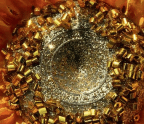
For more than two decades, the German artist Tobias Zielony has been tracking people in marginalized communities, and the spaces they occupy, through the lenses of both still and motion-picture cameras. Treading a blurry line between documentary and fiction, his images primarily capture youths whose often-challenging milieus elicit a yearning for self-determination and varied forms of self-representation. Zielony infiltrates, even joins, his subjects’ worlds—subcultures he finds around the globe, following his own curiosity, intuition, and instinct—to reveal the lesser seen layers of society.
Some of Zielony’s early photographic series depict protagonists caught in webs of poverty in places such as Canada and California; later series see him diving into nightlife subcultures in Eastern Europe and Asia. Beyond still photographs, Zielony has also produced videos, including Vele (2009–10), an eerie, abstract look into a mostly abandoned, monumental housing project on the outskirts of Naples, and Hurd’s Bank (2019), a fourteen-minute film based on oil smuggling off the coast of Malta. Last fall, while in Poland, Zielony spoke to the critic Kimberly Bradley about the strangeness of a mid-career survey exhibition, Tobias Zielony: The Fall, held in 2021 at the Museum Folkwang in Essen, Germany, and the difficulty of celebration in the midst of an ongoing global pandemic.
Kimberly Bradley: This issue’s theme is “celebrations” — but you’ve said your work isn’t celebratory, which makes this interview a bit of a challenge! Still, your recent retrospective could certainly be seen as a celebration of your oeuvre thus far: around four hundred people attended the opening last June, a small miracle during a pandemic. How did the exhibition come together?
: I was invited by the curator Thomas Seelig, and from 2000 and from 2001 to about the Scampia neighborhood in Naples. The other point was to have about half of the exhibition space devoted to videos, including (2014) and (2006). It was tempting to mount a big photography show, but we decided to add black-box spaces with projections and screens as well; in eleven or twelve rooms, the choreography went from bright to dark in a kind of topography that suits my work, which is so much related to night and darkness.






